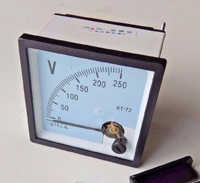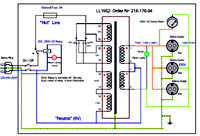Mains Balancer + Adapter from 230-240-250 to 230V.
We offer the transformer at the standard price. However, components like mains plugs, the relay, and other parts must be purchased separately.
This is a well-tested and reliable product, already built and used by many, including myself. I originally designed it for my 1954 Hammond B3 organ, which I've owned since 1990. Despite its excellent performance, the organ had always suffered from a low hum—until I used this solution to resolve the issue.
Solving the Hum Issue in My Hammond B3 Organ
After much trial and error, I finally discovered that the source of the hum in my 1954 Hammond B3 organ wasn’t due to the magnetic field, but the electric field. The B3, built entirely with tubes, uses a mechanical tone wheel generator that produces all the frequencies needed for sound. When you press a key, it connects to the appropriate tones, mixing up to 6 harmonics and 2 sub-harmonics in an adjustable way to create a remarkably programmable sound.
The challenge with this method lies in the very low signal generated by the tone wheels—around 15 millivolts. The generator itself is completely passive, using rotating iron wheels with wave patterns on their edges. A magnetic needle near the edge of the wheel detects the changes in magnetic flux, and a coil picks up this flux to produce the sound signal. It works much like an electric guitar pickup.
So far, so good, right? But the problem arises from the incredibly low signal, which makes it highly susceptible to external field radiation. When all 10 fingers are playing, you're picking up hum from potentially 50 individual coils. These have many different frequencies, but they have all the mains hum in common. All adding together to create an audible hum. You will see everywhere in the internet forums, people are struggling with this. Despite years of searching for a solution, and countless discussions with members of the German Hammond Club, I made no progress until I took a closer look at the mains transformer in the B3.
The transformer is mounted at a 45-degree angle to the chassis, which always seemed odd to me. It has a thick copper layer around it, which seems to act as a shield, minimizing the radiated fields. The Hammond engineers clearly chose the best position and angle for minimal radiation—down to the centimeter. And yes, they were aware of the hum, because otherwise they would not take such unconventional approach. But I still suspected the transformer’s radiation might be the source of the hum.
The issue is compounded by the fact that the B3 was designed for 110V power in the USA, but in Germany, we use 230V unbalanced power with an autotransformer to step it down. This difference produces twice the hum as with 110V. Also, the mains outlet in principle is always unbalanced—one wire has 230V AC, and the other has zero volts. Don't we all know that balanced signal have the least hum? So I decided to try this with the mains transformer, and that was the solution.
After experimenting with the transformer’s positioning, I found that it indeed radiated a field that contributed to the hum. The engineers had already positioned it as optimally as possible. The next step was to add an isolation transformer to break the loop and reduce the hum.
This led me to the solution: using an LL1662 isolation transformer. After 20 years of searching for a fix, I can confidently say this worked! The hum was reduced by about two-thirds, making a significant improvement in the sound quality. Now, the LL1662 sits inside my B3 and it will stay there.
For HiFi applications, an external box is required to house the isolation transformer, and you can easily build it yourself. Even a simple wooden box will work, as the LL1662 is a very low-radiation isolation transformer ideal for HiFi purposes.
So what can I improve? Coming back to the original problem, the mains outlets as a matter of principle are always unbalanced. So one wire of the mains cable has 230V AC on it, and the other wire has zero volt. My solution is shown in the schematic on the left. I discovered this way to use an isolation transformer, after searching for 20 years, what caused the hum in my Hammond B3. And I can say: This solution works! I think I got rid of 2/3 of the hum signal. There is now an LL1662 in my B3, and it will stay in there. The B3 is large size, and inside is enough space. For HiFi purposes, you need to build an external box, and connect all equipment to this box. The box can even be build from wood, because the Lundahl LL1662 is a very low radiation isolation transformer for HiFi purposes.
The solution in detail:
This solution isn’t just for a Hammond B3 — it’s applicable to any equipment that suffers from hum caused by mains cables and field radiation. I’m sure many of us have experienced the frustration of persistent hum, no matter what we try. At some point, it feels like a residue of noise remains, and that’s exactly where this solution comes in.
If you're dealing with hum that just won’t go away, I recommend balancing the mains voltage directly after the mains outlet. In both theory and practice, we know that balanced circuits are much less susceptible to hum, and they don’t radiate any unwanted noise. Hum works by the same mechanism: an unbalanced circuit will pick it up and, unfortunately, radiate it too.
Now, the mains outlet itself is the root of the problem. It’s inherently unbalanced. One wire carries the 230V signal, and the other is at zero volts—as unbalanced as it gets. While an unbalanced audio input (like a 1V signal) can pick up hum, this becomes much more problematic when the mains cable carries 230V. That’s a massive amount of unbalanced, unshielded energy!
These unbalanced, unshielded cables are often laid right behind equipment like for insrance your record player, CD player, and other sensitive gear. Instead of spending a small fortune on expensive "audiophile" power cables like the 'black mamba' or 'anaconda' cables with gold-plated connectors, consider this simple solution: build a balancing box for a fraction of the cost.
I can tell you from experience, this solution works far better than expensive cables. The noise reduction you’ll achieve will be far more noticeable than spending extra money on high-end power cables that claim to solve the problem through "voodoo."
Understanding the Mains Voltage and the Isolation Transformer
When we say there’s "230V" on the mains, we’re referring to the voltage on just one of the two wires. This wire is commonly referred to as the "hot" or "live" wire. The other wire, called the neutral, is ideally at zero volts (though it may fluctuate by a few volts).
Now, if we use an isolation transformer with a secondary center tap, we can connect the center tap to the primary neutral (not to be confused with the electrical ground). This setup has a unique advantage: while we lose the isolation property of the transformer, we gain balanced mains voltage.
Instead of the standard 230V, the transformer creates two 115V lines, each 180° out of phase with one another. For your equipment, this still looks like 230V, but in reality, one line will be at 115V, and the other will be at 115V with a phase shift of 180°. The result is a balanced voltage—a crucial factor in reducing hum and interference.
However, it’s important that the center tap is connected to the neutral line, not the live line. To ensure this, you need to plug in the primary correctly. Since we can’t always know which way is the correct way, a relay is used to ensure proper polarity. If you connect the mains incorrectly, the relay will activate, shutting off the transformer’s primary side. You’ll hear a “clack” sound, and the red lamp will light up, signaling the error.
When the mains is connected correctly, the relay will stay off, the green lamp will illuminate, and the voltmeter will show the voltage being supplied to your equipment.

I recently came across a new AC volt meter on eBay for just 10 Euros, which is a great value for anyone who needs to measure mains voltage.
One of the issues we face today is the variation in primary voltage. The transformer used in this setup offers a simple yet effective solution: it allows you to adapt the voltage in 10V steps. This is a great way to ensure more consistent performance across your equipment, especially when the mains voltage fluctuates.
What’s more, this transformer does more than just adapt the voltage. It continues to provide the filtering it’s designed for, removing any small DC components from the mains supply. The output is floating, thanks to the way the transformer is connected, adding another layer of isolation to your equipment.
All in all, this setup is an incredibly useful box for connecting your equipment, offering a variety of advantages by leveraging the Lundahl LL1662 transformer to its full potential. The LL1662 is an air-gapped transformer, which is key to making this possible.
For further details, be sure to read the text on the schematic as well—it provides additional context and explanation.

